I was recently asked by a friend to help find a guide on laser cutter selection.
I was surprised to learn that while there are many guides floating around the internet, no single guide was comprehensive enough to teach someone with no prior knowledge of laser cutting what they would need to know in order to make an informed purchasing decision.
While this is not meant to be the only reference someone should read if they are interested in purchasing a new laser cutter / engraver, it is intended to teach the fundamental differences between the most common laser cutter types.
The Difference Between Cutting and Engraving
In general, a laser machine will be used for one of two tasks, cutting through a material or engraving on the surface of a material. It is important to make this distinction, as some of the laser machine types listed below are better at one of these tasks or the other. Another term that is sometimes used when talking about laser machines is “marking“. Laser marking can refer to a number of different physical processes (engraving, annealing, staining, foaming, and carbonizing). In all of these processes, the common goal is to leave a visible mark on the surface of the material. source

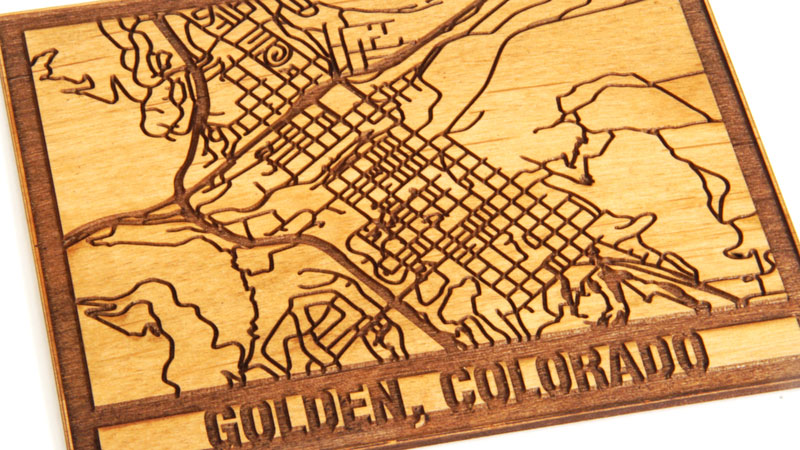
Laser Machine Types
This comparison will focus on the most common types of laser machines used by hobbyists.
-
CO2 laser machines (both Glass and Metal tube models)
-
Diode laser machines (often use blue laser diodes)
- Fiber laser machines (normally used for marking metal)
CO2 Laser Machines
CO2 laser machines used to be the most common type found in the homes and workshops of hobbyists.
These machines range in output power from about 20W to more than 100+. The power output of a laser cutter, measured in Watts, is the main factor in how thick of a material the machine can cut and how quickly it cuts.
CO2 laser machines are very versatile; they are capable of cutting and engraving a wide variety of materials. CO2 lasers are commonly used to cut and engrave materials such as wood, paper, and some types of plastic.
Here is a great article about using CO2 and Diode laser machines to cut wood.
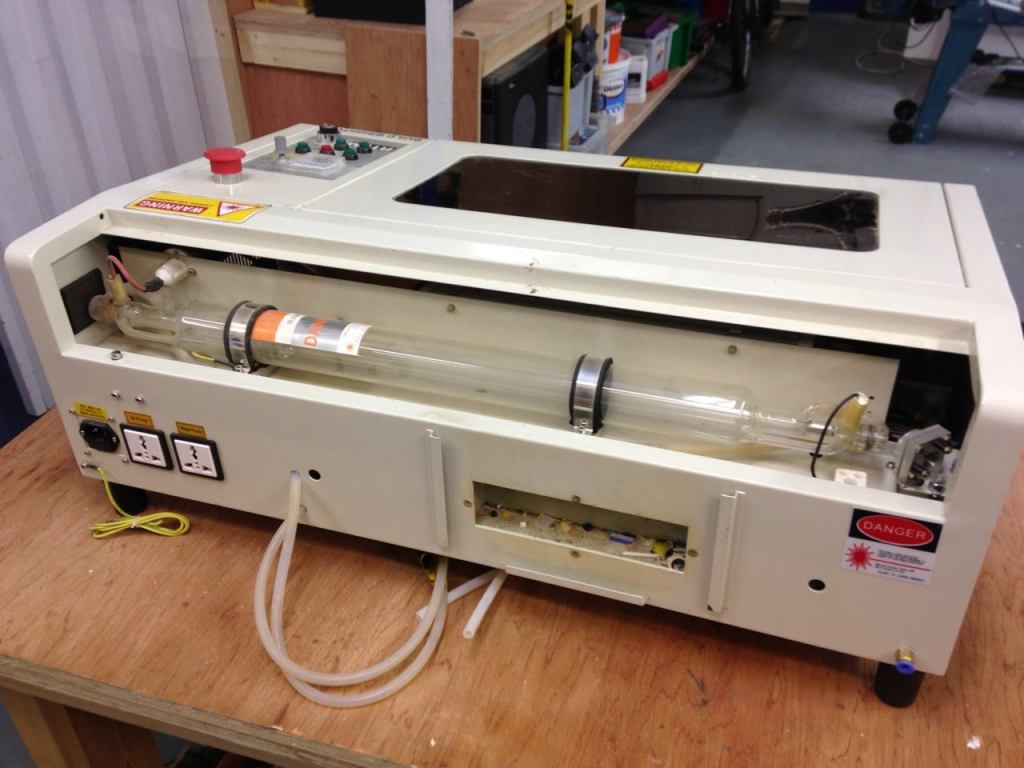
Image Credit
Diode Laser Machines
Diode laser machines have gained popularity over the last few years. Due to their low price point and general approachability, they are a popular choice for the average hobbyist. Diode laser machines are often sold for engraving purposes and generally lack the power required to cut through material quickly and cleanly. They also often lack simple safety features such as enclosures, which forces the operator and anyone else in the room to wear special laser safety goggles while the machine is in use.
I have little experience with this type of laser, as I have always had access to higher power CO2 laser machines, which can do many of the same tasks as a diode laser engraver but faster and often with better results. Here is an article comparing diode and CO2 lasers.

Image Credit
Fiber Laser Machines
Fiber laser machines have come down in price drastically over the past decade. While these machines used to sell for $20k+, they are now readily available for just over 1/10th of that price. Fiber lasers use a shorter wavelength of light than CO2 lasers. This shorter wavelength is more readily absorbed by metal, which means that even low-power fiber lasers are capable of marking and engraving metal surfaces. However, most fiber lasers in the price point accessible to hobbyists are not powerful enough to cut through even thin metal. Therefore, like diode lasers, these machines are often sold only as engravers, not cutters.
Here is a good comparison between fiber laser and CO2 laser machines.
Like CO2 machines, there are many nuances to selecting a fiber marking laser, power, motion system (galvo vs gantry), and laser source type (MOPA vs Q-switched). Due to the specialized applications of fiber lasers, I will not devote further space to them here.
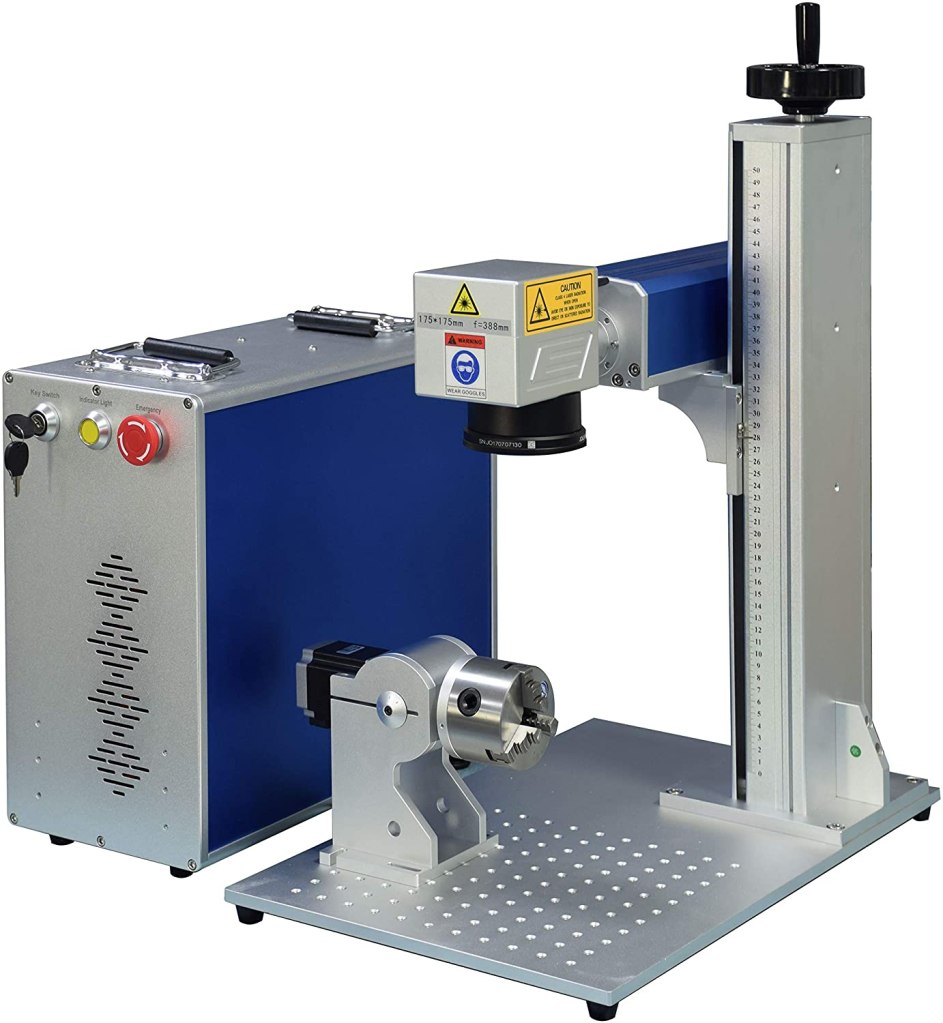
Image Credit
Laser Wavelength And Why It Matters
Each type of laser machine discussed above produces a different wavelength of light.
The materials that each type of laser can process are dependent largely on how the material in question responds to a given wavelength of light.
CO2 lasers operate at a wavelength in the region of 10 micrometers. At this wavelength they are efficient at heating many organic (carbon based) materials. Note that CO2 lasers generally emit 10.6um light but there are special versions which emit slightly different wavelengths which are better at marking plastics. source source
Diode lasers most commonly operate at a wavelength of .4um to 1um. Because these lasers often operate in the visible spectrum, the wavelength of operation can be seen as the color of the beam the laser produces. Because these lasers operate at a shorter wavelength than CO2 lasers, they can be less efficient at heating organic materials. source / comparison of diode and CO2 lasers
Fiber lasers most commonly operate at a wavelength of about 1um. This wavelength of light is efficient at heating many metals but is not as efficient at heating organic material. Therefore fiber lasers are not normally used for cutting wood or plastic. Fiber lasers are used for plastic marking where material removal is not needed. source source source
The Importance of Power When Selecting a Laser Machine
Beyond the type of laser, required cutting power is the next big decision to make when purchasing a laser machine. Put simply, the laser power a machine is capable of producing is directly tied to the amount of material the laser beam can remove in a given amount of time.
In the case of a CO2 laser cutter, the power specification is often used to understand how well the laser cutter will handle cutting through thick material. For instance a 40W laser machine may struggle to cut through 1/4″ (6mm) thick hard wood material but is perfectly acceptable for cutting through 1/8″ (3mm) of the same material, while an 80W machine may cut through both with ease.
When cutting thick material with a laser cutter, two strategies are often employed: the speed of the cut can be reduced, or the laser can be used to cut over the same line multiple times.
Reducing the speed of the cut allows the laser beam to have more time to cut through the material. The downside to this approach is that the laser beam also has more time to heat the surrounding material. This can result in fires, and often leads to excess smoke, which stains the surface of the material being cut.
Increasing the number of cutting passes reduces the risk of fire by allowing more time to cool before cutting the same area again, but is an inefficient cutting strategy, as the laser will need to cut through a layer of charred material before continuing to cut deeper into the base material. This strategy also tends to create more smoke, which can damage the surface of the material being cut.
The simple solution is to simply use more power with a single quick cut. After becoming very familiar with a 40W laser cutter, I was shocked at how clean the cuts from a 90W machine were. Because the laser didn’t need to make multiple passes or slow down to a crawl, the surface of my material was all but free of charring and smoke staining. Note that there are various techniques such as air assist or using tape on the surface of the workpiece that can reduce surface charing.
Here is a great deep dive on laser cutter power and speed.
The downsides to higher power CO2 machines is that they are generally larger and more expensive than their lower-power counterparts. In the case of Diode and Fiber lasers, the increased power will often increase price, but may not increase size.
With most laser machines, running the laser source at full power will reduce its life. A good rule of thumb is to avoid routinely running the laser at more than 80% of its rated power. With this in mind, it becomes clear why a higher power laser source may last longer than a lower power version. One can always turn down the output power of a high power laser when it isn’t needed, thus prolonging the life of the laser source.
Be careful when judging a Diode laser based on its power specification. Often, the power spec is exaggerated or outright false. With CO2 laser sources, the physical size of the laser tube is a good indication of power. In fact, it is common to see smaller machines with an extra “lump” on the side where a higher power tube was added.
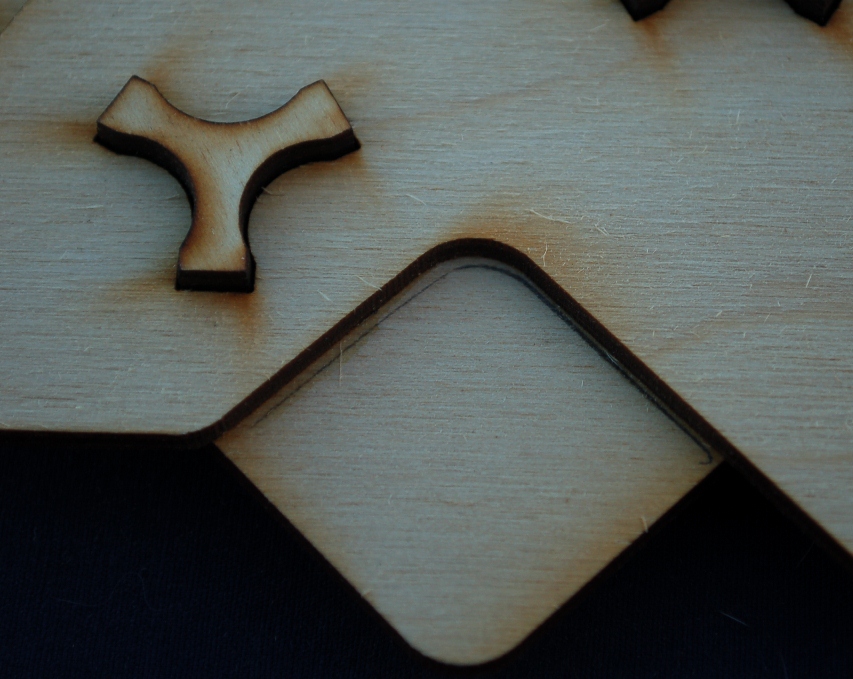

Types of CO2 Lasers
CO2 laser machines typically use one of two types of laser source (the part that actually makes the laser beam). Most inexpensive machines use a glass tube laser source; these laser tubes are relatively low cost and offer the best price / watt ratio of all of the laser options mentioned on this page.
Glass CO2 laser tubes are very common in the cheaper imported laser machines that people often gravitate to due to their approachable price. The power output of this style tube is almost always linked to the tube’s physical size. source
These tubes are excited by a very high voltage power supply (25,000 – 50,000 volts) which can be dangerous if handled or configured incorrectly. source
Almost all glass tubes are water cooled, which means that a tank of water, tubing, and a pump must be used while cutting or engraving with the machine. Most inexpensive machines come with tubing and an aquarium pump. It is expected that the user will provide a bucket of water that the pump sits in.
The power of the laser tubes is modulated by changing the current allowed to flow through the tube. Sometimes an ammeter is mounted to the control panel to show the tube current. On very cheap machines this current is set manually with a knob on the control panel of the machine. This is not desirable as the ability to set laser current in software allows for more advanced techniques such as cutting and engraving in the same job (without having to manually reset the machine between processes).
Not all glass tubes are created equal. Some higher quality tubes include features which prolong the tube’s life span. source
More premium C02 laser machines often skip the glass tube and instead use an RF excited metal cavity laser tube. These tubes have some advantages over glass tubes.
An RF tube is capable of pulsing its beam on and off much faster than a glass tube laser. This allows for finer engraving work than is possible with a glass tube machine. source (this article is also a great comparison of glass and metal tubes)
Many RF excited metal tubes are air cooled meaning no tank of water or leaks to worry about.
RF excited metal tubes do require an RF power source (on some tubes this is built in) but do not need a very high voltage DC power supply, they could therefore be considered safer than glass tubes. source
Metal tubes also often last longer than their glass counterparts. When a metal tube laser source has lost enough power it is often possible to have the tube refreshed (a process where the gas mixture in the tube is replaced with fresh gas). This process costs significantly less than buying a new metal tube but the refill service itself may cost more than buying a new glass tube. source
Unlike DC powered glass tube lasers, metal tube lasers pulse their beam to adjust power. Because of this some people notice a slightly rougher feeling edge on material that is cut with a metal tube laser. source

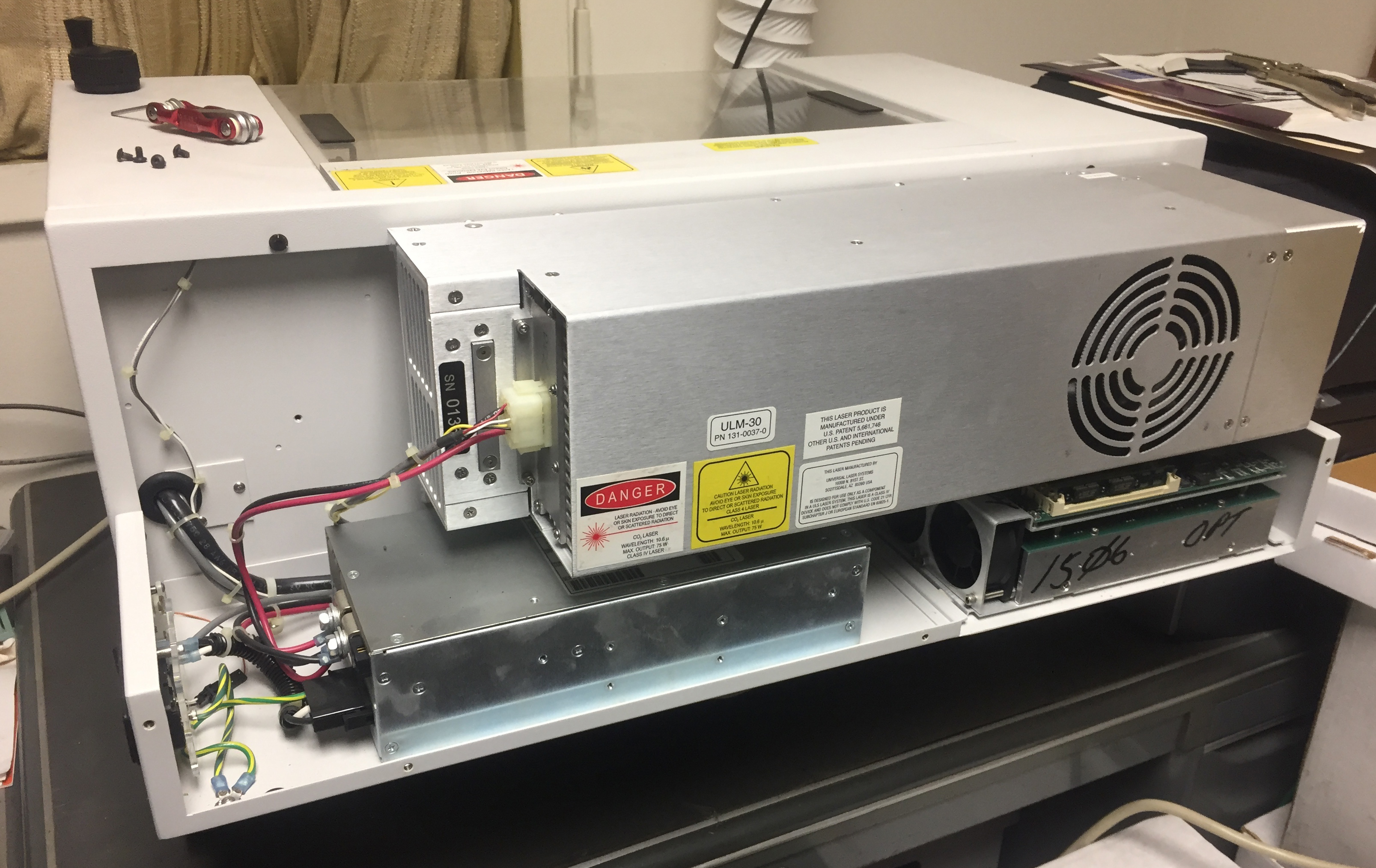
The Importance of Software When Using A Laser Machine
The software any given laser machine works with can make a huge difference to the usability of the machine. Two otherwise identical machines that are used with different software packages may have wildly diverging user experiences.
Most US made laser machines will come with custom software written by the manufacturer for that machine. Some imported machines that are sold by a “name brand” company will similarly use custom software (see Glow Forge and Full Spectrum). For most other machines, the software that the machine can use is determined by the type of laser machine control board installed on the machine.
Many of the larger and higher quality imported machines have Ruida controllers installed. These controllers are supported by RDWorks software which is the software that most commonly ships with these machines. While this software is quite useable it does not have a terribly intuitive interface and it does not support many of the features that one might find in a laser cutter such as the Glow Forge.
A great and inexpensive alternative to the stock software shipped with inexpensive laser cutters is LightBurn. LightBurn has an excellent user interface and works with many inexpensive laser cutters. If one wants to use LightBurn with a laser cutter that doesn’t have a supported control board, there are a number of third party control boards on the market that can be swapped in. This is especially notable for the “K40” series of lasers which almost universally ship with a pretty terrible controller and a cracked copy of coreldraw as “controller software”. See here and here for replacement control board kits for this style of laser cutter.

Image Source
Choosing a C02 Laser
When it comes to choosing a C02 laser there are many options. I tend to think of the market as being broken into 3 or 4 different categories.
US made machines intended for businesses or hobbyists willing to spend $5k – 50k.
– Trotec Laser
– Universal Laser
– Epilog Laser
All of these machines are offered with metal RF excited tubes and are excellent choices for engraving.
US companies that import laser machines from overseas and sell at a markup with better support and warrantees $2k – 20k
– Boss Laser
– Full Spectrum Laser
– Glow Forge
– Thunder Laser
– Laguna Tools
– Jamieson Laser
– Black Cat Labs
Some of the above companies sell imported machines that they put their names on, some sell machines that they designed then have manufactured overseas. In most cases these machines run similar electronics and are glass tube based machines. Most of these machines come with reasonably well thought out software (a much bigger deal than it initially appears).
Overseas companies that have brand recognition and sell machines under their own names
– Argus / Sunic Laser
– G-Weike Laser (I have been told that this company manufactures the Boss Laser machines)
– Aeon Laser
Most of the CO2 lasers offered by these companies come with glass tubes.
Generic laser cutters with no obvious manufacturer name $300 – 10k
This is the realm of the ubiquitous inexpensive eBay, Amazon, and Ali express laser machines.
These can offer a great value however one must exercise caution when purchasing these machines.
They are cheap but that is for a good reason, in addition to lower quality parts, they don’t normally come with good after sales support or warrantees.
The famous “K40” series of lasers often fit into this category of machines, as do the “Red” and “Yellow” larger machines.
Because of the low cost of entry into a reasonably high power machine, these are often people’s first pick for a laser cutter.
My recommendation is to only seriously consider these machines if you already have some experience with similar laser cutters. Despite coming assembled and “ready to go” be prepared for lots of tweaking to get these machines running well / safely. For instance, despite being labeled as 120v compatible many of these machines use smaller gauge wiring which is too thin to be safe when used at 120v instead of 240v where the current can be less for the same power delivery.
For more info on the “K40” style machines try this link or this link or this link or for more generic advice on imported laser cutters try this link. One important thing to note about K40 laser machines is that they often don’t have a mechanism for raising and lowering the cutting table, a feature that is important as laser cutters need to be focused for correct cutting performance.
Things to Think About Before Buying a Laser Machine
It can be easy to overlook some important aspects of using a laser cutter when buying one for the first time.
Here are some often overlooked topics that need to be thought about before hitting “Buy it now”
Venting the cutting fumes
When cutting or engraving a laser machine will produce smoke or fumes. These need to be safely vented outside or filtered. Most laser machines will come with a short section of 4″ or 6″ dryer vent duct and a fan to vent these fumes out of a window.
If there isn’t an easy way to vent the fumes outside a markedly more expensive option is to filter the smoke and fumes then release that air back into the room. There are some DIY options for this type of laser fume filter but for a safer and possibly more effective option I recommend the BOFA line of filters. They were some of the first to offer purpose built laser fume filter units but they can work well with regular filter changes. The down side to these units is that they often cost more than the laser machine itself so venting out a window is often the better way to go.
Despite having a good vent or filter, the fumes from laser cutting are almost always still noticeable within the room which the laser is working. For wood cutting and engraving this smell can be pleasant, a bit like a camp fire. When cutting plastics such as acrylic the smell is pretty terrible and often overpowering. For this reason laser cutting in one’s bedroom might be a poor idea.
Laser cutters can catch on fire and require constant monitoring
While generally safe to use, it is important to never leave a laser machine alone while it is working. While this isn’t too big a deal while performing some actions such as etching glass, laser cutter fires are common and it is important that they be identified and put out quickly. For this reason I always keep a fire extinguisher in the same room as my laser cutter and I never leave it alone while it is cutting or engraving flammable material.
There are many materials that are not safe to cut on a laser cutter
While a CO2 laser (specifically) is capable of processing a wide variety of materials there are many things that should never be placed into a laser machine. In most cases this is because these materials give off poisonous / corrosive fumes when cut / engraved. Here is a great list of materials and whether they are safe to cut or not. Almost any maker space that has laser cutters will have a similar list of “do not cut” materials.
Laser cutters are often loud and annoying to work around
This is not a universal rule but with the exception of the low power diode lasers and expensive fiber lasers, most laser machines require fume extraction. That means that there is going to be at least one large blower fan near the laser. These fans are not particularly quiet. In fact on many laser machines I have worked with the fan is normally turned on just before cutting (and is easy to forget). This is simply because it is too annoyingly loud to leave the exhaust fan on the entire time that the machine is on while setting up a cut.
Likewise, glass tube (and some metal tube) laser cutters have a water pump that makes noise while the machine is on. Even on metal tube laser machines that have an air cooled tube (such as the one I own) the cooling fans are not quiet.
For these reasons it may not be a good idea to routinely use a laser cutter in the same room as people who are trying to sleep, relax, or watch tv.